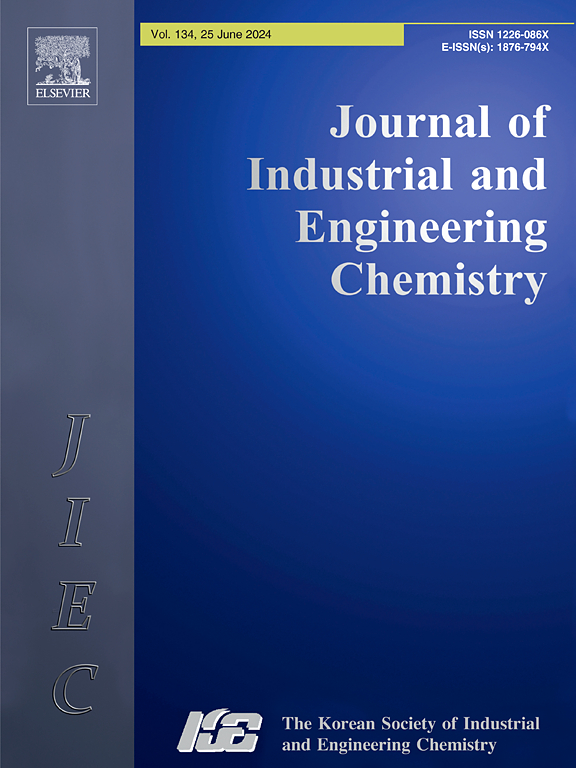Mitochondrial dysfunction and fibrosis in atrial fibrillation: Molecular signaling in fast-pacing organoid models
IF 5.9
3区 工程技术
Q1 CHEMISTRY, MULTIDISCIPLINARY
Journal of Industrial and Engineering Chemistry
Pub Date : 2025-06-28
DOI:10.1016/j.jiec.2025.06.038
引用次数: 0
Abstract
Atrial fibrillation (Afib) presents significant public health challenges due to its complex mechanisms and elevated risks of stroke and heart disease. This study employs 3D fast-paced organoid models derived from human-induced pluripotent stem cell-derived cardiomyocytes (hiPSC-CMs) to investigate mitochondrial dysfunction and cardiac fibrosis in Afib at the molecular level. Rapid pacing at 3 Hz for 24 h triggered a 50 % decline in peak contraction amplitude and a 55 % reduction in contraction velocity. Multi-omics profiling revealed pronounced mitochondrial injury—succinate dehydrogenase sub-units SDHA–D decreased by 35–60 % and the master regulator PGC-1α fell 48 % together with a 2.3-fold increase in cytosolic cytochrome-c. Profibrotic signalling was activated in parallel (AGTR1 was up-regulated 2.1-fold, TGF-β1 was up-regulated 2.5-fold), driving extracellular-matrix accumulation (collagen-I and α-SMA levels rose 1.9- and 2.2-fold, respectively). Public Gene Expression Omnibus (GEO) datasets further validated the clinical relevance of our model; the organoid transcriptional fingerprint correlated strongly with human atrial-tissue fibrosis signatures (R = 0.71, p < 0.001; GSE128188), highlighting its translational value. Collectively, these quantitative data demonstrate that 3-D fast-paced organoids recapitulate both the functional impairment and synchronous mitochondrial-fibrotic remodeling characteristic of early Afib. Taken together, coupling high-resolution functional metrics with multi-omics read-outs elevates cardiac-disease modelling and can accelerate the development of targeted therapies for atrial fibrillation.心房颤动的线粒体功能障碍和纤维化:快速起搏类器官模型中的分子信号传导
心房颤动(Afib)由于其复杂的机制和卒中和心脏病的高风险,提出了重大的公共卫生挑战。本研究采用人类诱导的多能干细胞来源的心肌细胞(hiPSC-CMs)衍生的3D快节奏类器官模型,在分子水平上研究Afib的线粒体功能障碍和心脏纤维化。以3hz频率快速起搏24小时,可导致收缩峰值幅度下降50%,收缩速度下降55%。多组学分析显示,线粒体损伤-琥珀酸脱氢酶亚基SDHA-D下降了35 - 60%,主调节因子PGC-1α下降了48%,胞浆细胞色素-c增加了2.3倍。促纤维化信号被平行激活(AGTR1上调2.1倍,TGF-β1上调2.5倍),驱动细胞外基质积累(胶原- i和α-SMA水平分别上升1.9倍和2.2倍)。公共基因表达综合(GEO)数据集进一步验证了我们的模型的临床相关性;类器官转录指纹图谱与人心房组织纤维化特征密切相关(R = 0.71, p <;0.001;GSE128188),突出了其翻译价值。总的来说,这些定量数据表明,3-D快节奏类器官概括了早期房颤的功能损伤和同步线粒体-纤维化重构特征。综上所述,将高分辨率功能指标与多组学读数相结合可以提高心脏病建模,并可以加速心房颤动靶向治疗的发展。
本文章由计算机程序翻译,如有差异,请以英文原文为准。
求助全文
约1分钟内获得全文
求助全文
来源期刊
CiteScore
10.40
自引率
6.60%
发文量
639
审稿时长
29 days
期刊介绍:
Journal of Industrial and Engineering Chemistry is published monthly in English by the Korean Society of Industrial and Engineering Chemistry. JIEC brings together multidisciplinary interests in one journal and is to disseminate information on all aspects of research and development in industrial and engineering chemistry. Contributions in the form of research articles, short communications, notes and reviews are considered for publication. The editors welcome original contributions that have not been and are not to be published elsewhere. Instruction to authors and a manuscript submissions form are printed at the end of each issue. Bulk reprints of individual articles can be ordered. This publication is partially supported by Korea Research Foundation and the Korean Federation of Science and Technology Societies.

 求助内容:
求助内容: 应助结果提醒方式:
应助结果提醒方式:


